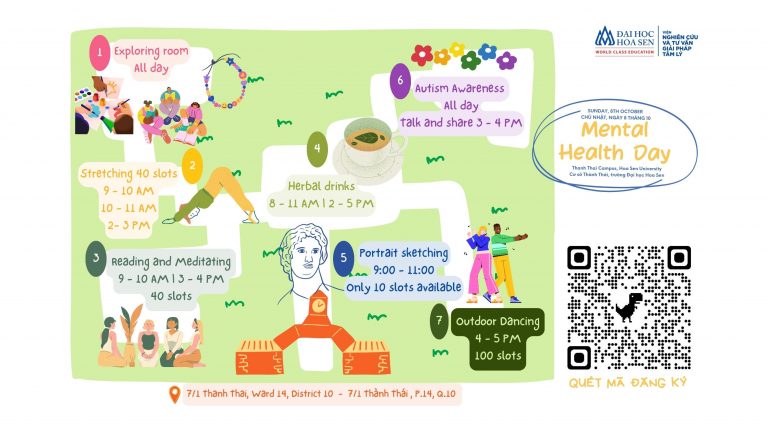Fighting sexism in toy stores: Are Barbie dolls for boys?
March 15, 2022
Author/Author: Ph.D. Michelle Smith, Deakin University
Translator/Translator: Doan Thi Ngoc – Teacher-Lecturer, Hoa Sen University (HSU)

“I don’t encourage my daughter to play with Barbie dolls and wear bright fairy tale costumes, but she is very strongly attracted to them.”
Faced with the idea that gender stereotypes and gendered marketing have a significant impact on children’s play, many parents have made claims that girls have an innate tendency to buy pink and sparkly toys.
Not only do many parents deny that gender stereotypes shape the types of toys children feel allowed to play with, but even the Australian Prime Minister thinks so. Upon hearing about the “No Gender December” campaign, which encouraged people to consider what toys they would buy before Christmas, Australian Prime Minister Tony Abbott dismissed it as that it is “a euphemism for political correctness”. He argues that we must, “let boys be boys and let girls be girls – let boys be boys, let girls be girls”.
However, No Gender December and similar campaigns like Let Toys Be Toys show that gender stereotypes about toys limit children’s creativity and development. They also argue that separating toys for girls and boys contributes to gender inequality by singling out certain professions and jobs as unsuitable for one sex or the other. other nature.

The idea of “ letting children “be” boys or girls ” implies that there is a natural set of likes and dislikes for each gender, which is not influenced by the culture in which we live. Behind this view is the perception that toy preferences are rooted in biology, such that only girls are attracted to dolls because of their nurturing role, whereas boys are attracted to dolls. by dynamic toys like guns.
There are several problems with this view. First, taking a type of toy as an example, very young boys seem to be attracted to dolls. Cordelia Fine’s Delusions of Gender refers to a study that measured children’s reactions to dolls and found that boys only began to reject dolls at an age when they could be taught that dolls were only for girls.

If we can create an environment in which cultural views of gender stereotypes are limited and there is no sexism for children through the media, advertising, or being influenced by their friends or parents, many boys will likely continue to show an interest in dolls from an early age as some do regardless of these prejudicial factors. That’s really what it means to let “boys be boys”.
Indeed, such an effort to counteract the impact of gender segregation in toy stores is already underway in Sweden.
In 2012, Top Toy, the company that owns the franchise for Toys R Us in Sweden, produced a catalog with a girl showing dexterity using a Nerf gun, a boy holding a doll, and a baby. Boys and girls are playing in the doll’s house. International media reports on this toy category have reacted predictably and suggested that the separation of toys by gender was a reflection of children’s natural preferences but the concept Gender neutrality is weird and fake.
However, Toys R Us Sweden continues to aim for gender neutrality in its stores, with the layout varying so that masculine and feminine toys are often interspersed throughout the aisles.
Second, supposedly “natural” preferences for particular types of toys or colors vary according to what our culture believes is appropriate for children and what the toy industry finds profitable.
For example, we know that the “pinkization” of girls’ toys is a relatively recent phenomenon, driven in part by the desire to improve sales by offering The most harmful thing is that siblings of the opposite sex cannot use it.
Similarly, while Lego was once imagined as a gender-neutral toy that encouraged creativity and the development of fine motor skills, in recent years a separate product line for girls, which involved creative freedom, became a bestseller.

We promote the idea that the types of toys children play with help shape the kind of person they want to be, especially in terms of their level of masculinity or femininity. Even children know well enough about sexist actions like “gender police” if a boy or girl tries to play with a toy other than those accepted for his or her gender.
The No Gender December campaign notes that:
It’s 2014 – women mow lawns and men push baby carriages, but while we’re starting to move towards gender equality, many toy companies are staying the same.
Although some key signs of gender inequality remain unwavering in countries including Australia, and the majority of housework and childcare is still done by women, more and more women are doing it. social work. High-paying industries and senior positions in most fields are still dominated by men, while female occupations that involve caring for or working with children, still pay low salaries.
The segregation of children’s toys in store aisles reflects a society that normalizes gender inequality and children are taught to understand that disparities between the social roles of men and women are impossible. avoid.
Although making it easy for girls who want to go on adventures what they want, and helping boys who want to show interest in everything from clothes to playing with Barbie dolls will not be a single factor. gender inequality cannot be corrected, but at least it will help minimize the formation of gender stereotypes during childhood. This also does not prevent girls from being girls or boys from being boys.
The Conversation newspaper and author Michelle Smith, Deakin University allowed Gendertalkviet to translate into Vietnamese and post the full text. On behalf of the Gender Talk Editorial Board, we would like to send our sincere thanks to the Author and The Conversation Newspaper for allowing us to republish the full text. The contributions of The Conversation Newspaper and the author are very valuable and meaningful.
Original link: https://theconversation.com/barbie-for-boys-the-gendered-tyranny-of-the-toy-store-34979
Vietnamese Link: https://gendertalkviet.blogspot.com/2022/02/chong-lai-phan-biet-gioi-tinh-trong-cua.html
















